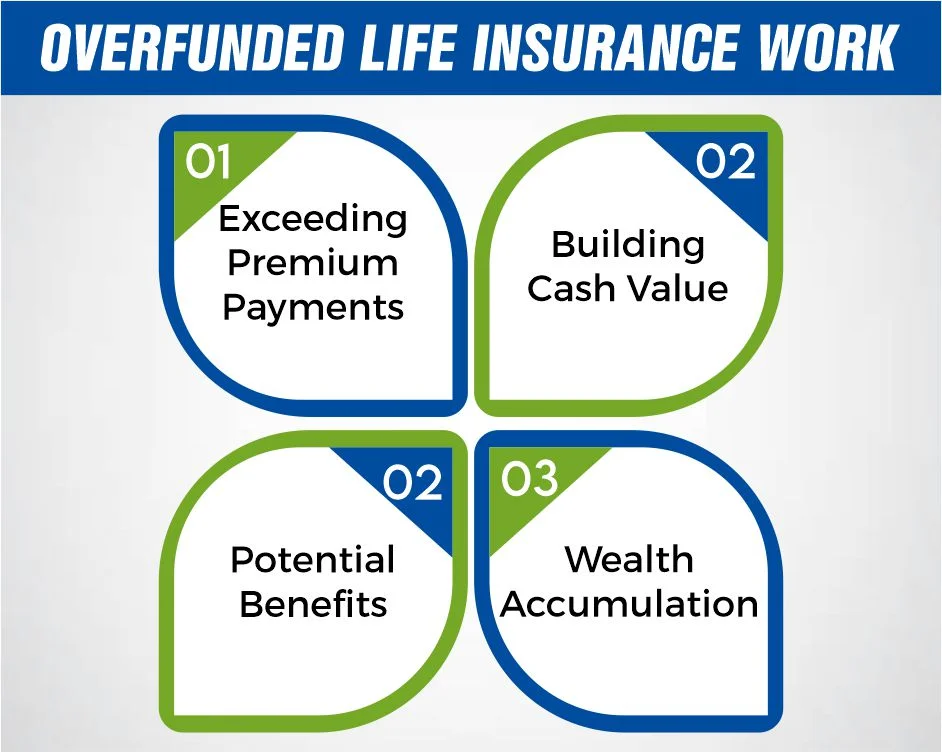Do you think that life insurance is something that only offers protection? Well! Think twice as life insurance plans are a gateway to many financial strategies that go beyond security. This is where overfunding life insurance steps in; a smart and easy approach for transforming policies into wealth-building tools.
But what exactly is overfunding? How does it work? And what does it mean to overfund your life insurance plan? Get ready as we are going to explore all these questions and a lot more in this blog post. We will help you to discover how overfunding life insurance can turn your policy into a powerhouse for financial growth and security.
If you’re curious about optimizing your life insurance for more than just coverage, this article is for you. Let’s navigate the lanes of overfunding and uncover the secrets behind this intriguing strategy.
What Is Overfunded Life Insurance?
Overfunded life insurance refers to a strategy where policyholders contribute more money than required to meet the premiums of a life insurance policy. These surplus funds go beyond the necessary payments and get directed into the policy’s cash value.
Typically associated with permanent life insurance policies, overfunding allows individuals to build up the cash value of their policy more quickly than through standard premium payments alone. This surplus cash value accumulates and grows tax-deferred, offering potential benefits such as increased cash value growth, potential tax advantages, and the ability to access the accumulated cash value through policy loans or withdrawals in the future.
The practice of overfunding life insurance is a strategic financial move aimed at maximizing the benefits and potential of the policy as a tool for wealth accumulation and financial planning beyond its primary death benefit protection.
What does it mean to overfund your life insurance?
To overfund your life insurance means making contributions beyond the required or scheduled premium payments set by the insurance policy. This payment goes directly into the policy’s cash value, distinct from the amount needed to maintain the policy’s coverage.
Generally associated with permanent life insurance policies, such as whole life or universal life, overfunding involves intentionally paying more than the necessary premiums to accelerate the growth of the policy’s cash value. By overfunding, policyholders aim to build up the cash value component of the policy faster than through regular premium payments.

How does overfunded Life insurance work?
Overfunding life insurance works by exceeding the minimum premium payments required to keep the policy active. Here’s how the process generally functions:
1- Exceeding Premium Payments
Policyholders make additional payments beyond what’s necessary to maintain the insurance coverage. These surplus contributions are typically made into permanent life insurance policies, like whole life or universal life.
2- Building Cash Value
The surplus payments accumulate within the cash value portion of the policy rather than solely going toward the death benefit. This cash value grows tax-deferred, potentially accumulating more rapidly due to the extra contributions.
3- Potential Benefits
The additional cash value accumulation offers potential advantages, such as increased funds available for policy loans or withdrawals in the future, potential tax benefits, and a faster growth rate compared to the policy’s regular cash value growth through standard premiums.
4- Wealth Accumulation
Overfunding can serve as a strategy for building a tax-advantaged cash reserve or as a supplementary source of income during retirement.
Remember, the mechanics of overfunding can vary based on the specific policy, insurance company, and individual circumstances, so it’s crucial to consult with a financial advisor or insurance professional before implementing an overfunding strategy.
Pros & Cons of Overfunded Life Insurance
Let’s explore the pros and cons of overfunding life insurance:
Pros of Overfunding Life Insurance
- Tax Advantages: Surplus contributions accumulate tax-deferred within the policy’s cash value, potentially resulting in tax-free withdrawals or loans in the future.
- Cash Value Growth: Overfunding accelerates the growth of the policy’s cash value, offering a larger pool of funds for potential loans or withdrawals.
- Asset Protection: Cash value in life insurance policies often enjoys creditor protection, providing an added layer of financial security.
- Supplemental Income: The accumulated cash value can serve as a supplemental income source during retirement or financial emergencies.
Cons of Overfunding Life Insurance
- Risk of Policy Lapse: Relying heavily on overfunding might lead to potential policy lapse if contributions are not maintained, risking the coverage.
- Reduced Death Benefit: Excessive overfunding could diminish the policy’s death benefit, impacting the original purpose of life insurance.
- Complexity and Fees: Overfunded policies may involve higher fees or complexities in managing the surplus contributions and cash value.
- Potential MEC Status: Excessive overfunding might inadvertently turn the policy into a Modified Endowment Contract (MEC), affecting its tax treatment and potential penalties for withdrawals.
What are other options besides overfunding your life insurance?
Besides overfunding life insurance, there are several alternative options for individuals seeking to build wealth or enhance their financial security:
1- Retirement Accounts
Contributing to tax-advantaged retirement accounts like IRAs (Individual Retirement Accounts) or 401(k)s offers potential tax benefits and long-term growth opportunities.
How Much Does Life Isurance Cost?
2- Investment Portfolios
Creating a diversified investment portfolio with stocks, bonds, mutual funds, or real estate can generate potential returns and wealth accumulation.
3- Health Savings Accounts (HSAs)
HSAs allow tax-deductible contributions for qualified medical expenses, offering potential tax benefits and a reserve for healthcare costs.
4- 529 Plans
These plans provide tax advantages for saving for education expenses, making them suitable for funding educational needs for oneself or family members.
5- Taxable Investment Accounts
Investing in non-retirement accounts can provide flexibility and liquidity without the restrictions of retirement accounts.
6- Annuities
Considered for retirement planning, annuities offer tax-deferred growth and periodic payments, providing a steady income stream during retirement.
Each of these alternatives comes with its own set of advantages, disadvantages, and considerations. The choice depends on an individual’s financial goals, risk tolerance, and specific circumstances.
What are the reasons for choosing overfunded life insurance policies?
Several reasons prompt individuals to choose overfunding life insurance policies:
Supplemental Retirement Income
The accumulated cash value can act as a supplementary income source during retirement, offering financial stability beyond other retirement savings.
Estate Planning
Overfunding life insurance allows policyholders to leave a more substantial legacy by increasing the potential death benefit or passing on tax-advantaged assets to beneficiaries.
Asset Protection
Cash value in life insurance policies often enjoys creditor protection, safeguarding assets against potential creditors or legal claims.
Flexible Access to Funds
The accumulated cash value can be accessed through policy loans or withdrawals for various financial needs, providing liquidity and flexibility.
Diversification of Assets
Overfunding life insurance offers an additional asset class diversification, complementing other investment strategies.
The Modified Endowment Contract (MEC)
A Modified Endowment Contract (MEC) refers to a life insurance policy that has been funded with amounts that exceed the limits set by the Internal Revenue Service (IRS) under the tax code. When a life insurance policy crosses these funding thresholds, it loses some of its tax advantages and is classified as a MEC.
Key features of a MEC include:
- Tax Treatment: Withdrawals or loans from a MEC are subject to different tax rules. Specifically, any gains withdrawn or borrowed against the policy are subject to income tax and potentially a 10% penalty if taken before age 59½.
- Changes in Tax Benefits: MECs lose some of the tax advantages associated with life insurance policies. Policy loans or withdrawals are treated on a Last-In-First-Out (LIFO) basis, meaning that any gains are accessed first and taxed as ordinary income.
- Contribution Limits: The IRS sets limits on how much premium can be paid into a life insurance policy over a certain period. When a policy breaches these limits, it becomes a MEC.
- Complexities: MEC status triggers changes in the policy’s taxation, altering the way contributions, withdrawals, loans, and policy distributions are treated for tax purposes.
It’s crucial for policyholders to be aware of these MEC regulations when considering overfunding life insurance policies, as inadvertently turning a policy into a MEC can significantly impact the tax treatment of policy distributions.
The Modified Endowment Contract (MEC)
A Modified Endowment Contract (MEC) refers to a life insurance policy that has been funded with amounts that exceed the limits set by the Internal Revenue Service (IRS) under the tax code. When a life insurance policy crosses these funding thresholds, it loses some of its tax advantages and is classified as a MEC.
Key features of a MEC include:
- Tax Treatment: Withdrawals or loans from a MEC are subject to different tax rules. Specifically, any gains withdrawn or borrowed against the policy are subject to income tax and potentially a 10% penalty if taken before age 59½.
- Changes in Tax Benefits: MECs lose some of the tax advantages associated with life insurance policies. Policy loans or withdrawals are treated on a Last-In-First-Out (LIFO) basis, meaning that any gains are accessed first and taxed as ordinary income.
- Contribution Limits: The IRS sets limits on how much premium can be paid into a life insurance policy over a certain period. When a policy breaches these limits, it becomes a MEC.
- Complexities: MEC status triggers changes in the policy’s taxation, altering the way contributions, withdrawals, loans, and policy distributions are treated for tax purposes.
It’s crucial for policyholders to be aware of these MEC regulations when considering overfunding life insurance policies, as inadvertently turning a policy into a MEC can significantly impact the tax treatment of policy distributions.
MEC (Modified Endowment Contract) vs Overfunded Life Insurance
Understanding the distinctions between a Modified Endowment Contract (MEC) and Overfunded Life Insurance is pivotal when considering life insurance strategies. Both involve surplus contributions, yet their implications and functionalities diverge significantly.
1- Purpose and Tax Treatment
MEC Tax Status: When a life insurance policy surpasses certain funding limits set by the IRS, it’s categorized as a MEC. Contributions exceeding these limits result in altered tax treatment.
Overfunding Tax Implications: Overfunding aims to accelerate cash value growth within a policy while maintaining its tax benefits, allowing for tax-deferred growth and potential tax-free withdrawals.
2- Tax Treatment of Distributions
MEC Tax Rules: Withdrawals or loans from a MEC incur income tax on gains and a potential 10% penalty if taken before age 59½. Taxation follows a Last-In-First-Out (LIFO) basis.
Overfunded Policy Taxation: Overfunding maintains tax advantages associated with life insurance, facilitating tax-deferred growth and potential tax-free access to accumulated cash value.
3- Contribution Limits and Complexity
MEC Contribution Limits: IRS imposes caps on premiums paid into a policy over a defined period. Crossing these thresholds designates a policy as a MEC, altering its tax benefits.
Overfunding Complexity: While overfunding involves intentional surplus payments, it doesn’t trigger the same contribution limits or tax ramifications as a MEC. However, managing surplus contributions may introduce some complexities.
4- Impact on Policy Benefits
MEC and Policy Benefits: Once a policy becomes a MEC, it loses some of the tax advantages and benefits associated with traditional life insurance, impacting policyholder benefits and distributions.
Overfunding and Policy Benefits: Overfunding aims to enhance the cash value of the policy without jeopardizing its original benefits or tax advantages, offering increased financial flexibility and potential wealth accumulation.
5- Flexibility and Control
MEC Limitations: MEC status imposes stricter tax rules and limits on how policy distributions are treated, potentially reducing the flexibility of using the policy’s cash value.
Overfunding Flexibility: Overfunding maintains the flexibility of accessing cash value for loans or withdrawals without the same strict tax implications, providing more control over financial planning strategies.
Conclusion
Overfunding life insurance presents opportunities for accumulating wealth, tax advantages, and additional financial security. However, it’s essential to weigh the benefits against potential risks and complexities before adopting this strategy. Always consult with a financial advisor or insurance professional before making significant changes to your life insurance policy.
Frequently Asked Questions (FAQs)
1- Is Overfunding a Term Life Insurance Policy a Viable Strategy?
Overfunding a term life insurance policy isn’t feasible since term policies lack cash value. Overfunding typically applies to permanent life insurance policies.
2- Do Permanent Life Insurance Policies Benefit From Overfunding?
Yes, permanent life insurance policies, such as whole life or universal life, can benefit from overfunding by accumulating cash value that grows tax-deferred.
3- How Much Can You Overfund a Whole Life Policy?
The maximum overfunding amount depends on various factors, including the policy’s terms, your age, health, and the insurer’s guidelines. It’s advisable to consult with a financial advisor or an insurance professional to determine an appropriate overfunding strategy for your specific circumstances.
4- What Are the Wealthy Doing with Overfunded Life Insurance?
Many affluent individuals utilize overfunded life insurance as a versatile financial tool. They leverage the tax benefits, access to cash value, and potential estate planning advantages to bolster their financial portfolios.

Joyce Espinoza, Expert Life Insurance Agent
Joyce Espinoza is a trusted life insurance agent at mLifeInsurance.com. She’s been in the insurance industry for over ten years, helping people, especially those with special health conditions to find the right coverage. At MLife Insurance, Joyce writes easy-to-understand articles that help readers make smart choices about life insurance. Previously, she worked directly with clients at Mlife Insurance, advising nearly 3,000 of them on life insurance options.


